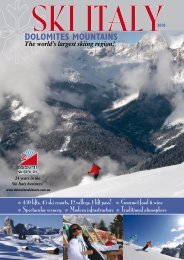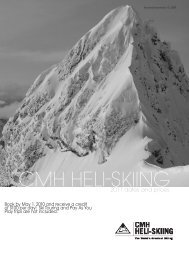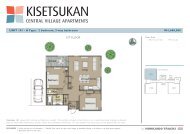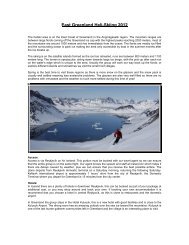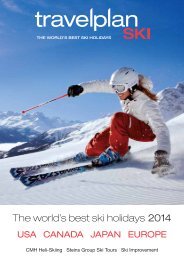Fibre-reinforced Composite Resin Bridges
Fibre-reinforced Composite Resin Bridges
Fibre-reinforced Composite Resin Bridges
You also want an ePaper? Increase the reach of your titles
YUMPU automatically turns print PDFs into web optimized ePapers that Google loves.
GC Corporation and Professor Ian Meyers present<br />
A two day hands on training course at the world class training facilities at GC Corporation, Tokyo.<br />
Managing the worn dentition, and <strong>Fibre</strong>-<strong>reinforced</strong> <strong>Composite</strong> <strong>Resin</strong> <strong>Bridges</strong><br />
9 th and 10 th January 2013; 8.45am till 4.30pm<br />
Course attendance limited to 20 people<br />
Day ONE<br />
<strong>Fibre</strong>-<strong>reinforced</strong> <strong>Composite</strong> <strong>Resin</strong> <strong>Bridges</strong><br />
Course outline<br />
In recent years fibre-<strong>reinforced</strong> resin composites have gained increasing acceptance in clinical and laboratory<br />
applications. The combination of good aesthetics and high fracture toughness, as well as enabling minimally<br />
invasive treatment to be undertaken, provides the clinician with many alternative treatment options for<br />
patients. The most significant advantages for patients relate to cost effectiveness, conservation of tooth tissue<br />
and reduced treatment time in comparison with other complex restorative procedures. <strong>Fibre</strong>-<strong>reinforced</strong><br />
bridges can be very successful in replacing both missing anterior and posterior teeth, either as a short term<br />
solution or for longer term aesthetics and function. Their short term use over healing implant sites provides a<br />
more comfortable and acceptable alternative to a partial denture in many cases, and they can be placed and<br />
replaced with minimal chair time. <strong>Bridges</strong> can be constructed directly, fabricated chair-side or pre-made in the<br />
laboratory providing great flexibility in techniques available.<br />
This course will provide clinical information and a ‘hands-on’ experience with various fibre <strong>reinforced</strong> materials<br />
combined with a range of aesthetic and high strength composite resins. Techniques for creating aesthetic<br />
anterior and fully functional posterior fibre <strong>reinforced</strong> bridges will be discussed and demonstrated.<br />
Participants will be able to experience using the various fibre <strong>reinforced</strong> materials and undertake construction<br />
of direct and semi-direct bridges. Materials handling and clinical hints and tips will be highlighted to assist in<br />
ensuring successful patient outcomes.<br />
Course topics<br />
• <strong>Fibre</strong> <strong>reinforced</strong> composites – material types and indications for use<br />
• Case selection, treatment options and clinical techniques<br />
• Using aesthetic composites and layering with anterior fibre <strong>reinforced</strong> bridges<br />
• Creating high strength, aesthetic and functional posterior fibre <strong>reinforced</strong> composite resin bridges<br />
• Hands-on construction techniques<br />
• Longevity and maintenance of restorations<br />
Course objectives<br />
• Understanding advantages and disadvantages of different resin reinforcing materials<br />
• Develop skills in handling reinforcing fibres with different composite resin materials<br />
• Undertake construction of anterior and posterior resin <strong>reinforced</strong> composite resin bridges<br />
• Learn direct, semi-direct and indirect techniques for restoration<br />
• Aesthetic layering for maximum aesthetics
Day TWO<br />
Managing the Worn Dentition<br />
What strategies are required as patients and their restored dentitions age?<br />
Restoration of an extensively worn or badly broken down dentition can be complex, costly and time<br />
consuming to implement. Because of its complexity and cost, this treatment is often delayed until it becomes<br />
essential.<br />
Dentists (and patients!) want to stop the repeat restoration cycle and its ongoing costly restorative burden. So<br />
how do we treat the patient with a severely broken down dentition?<br />
Through lectures, clinical demonstrations and participation exercises, Professor Meyers will present four steps<br />
to restorative success:<br />
Clinical evaluation of patients<br />
• Review of a number of patient cases<br />
• Risk assessment tools<br />
• Impact of patient’s health and lifestyle<br />
• Correct treatment planning prior to restoration<br />
Oral environment<br />
• How dry mouth and salivary acidity correlates with severe tooth wear and non-carious tooth surface<br />
loss<br />
• Examination requirements, salivary analysis and remineralisation strategies<br />
• Stabilisation of the oral environment and risk reduction prior to restoration<br />
New materials and techniques<br />
• How to evaluate the range of materials and techniques available for cost-effective and conservative<br />
management; and aesthetics<br />
• Step by step procedures (using a range of materials) to allow participants to compare the various<br />
materials and techniques for direct and semi-direct restorations<br />
Practical experience<br />
• Demonstration and participant simulation exercises covering techniques for the restoration of the<br />
worn dentition; including direct restorative techniques, laboratory procedures, direct, semi-direct and<br />
indirect adhesive technologies<br />
About the presenter:<br />
Professor Ian Meyers<br />
BDSc, FICD, FADI, FPFA, FRACDS<br />
Ian Meyers is currently in general dental practice in Brisbane, Australia and has honorary professorial positions<br />
with The University of Queensland School of Dentistry, and James Cook University School of Medicine and<br />
Dentistry. He is also currently the President of the Queensland Branch of the Australian Dental Association.<br />
Following his graduation from The University of Queensland in 1982 he spent a number of years in private<br />
practice and government dental clinics. Ian then commenced working for The University of Queensland in<br />
1988 and was the inaugural Colgate Chair of General Dental Practice from 2001 – 2009, and Chief Dental<br />
Officer for Queensland Health from 2009 – 2010. He has been involved in a wide variety of research projects in<br />
the applied dental biomaterials area and has run many postgraduate and continuing education courses on<br />
diagnosis and conservative management of tooth wear. He is a product consultant to a range of dental<br />
companies and is chairman of the ADA Dental Instruments, Materials and Equipment Committee. He is a<br />
member of the International Association for Dental Research, Chairman of the Australian Dental Research<br />
Foundation Research Advisory Committee and on the Board of Directors for the Australian Dental Research<br />
Foundation. In addition he is a member of the editorial board of The Australian Dental Journal and several<br />
other international journals. His major interests include adhesive restorative dental materials, diagnosis and<br />
management of the worn dentition and teaching and clinical development in general practice dentistry.
Course Fee:<br />
$1,540<br />
Includes:<br />
All materials and course notes<br />
Welcome cocktails. 6.30pm – 8.00pm. Tuesday 8 th January 2013<br />
Course participants’ dinner. 7.00pm. Wednesday 9 th January 2013<br />
For Partners:<br />
A variety of day tours are available from Tokyo Dome Hotel<br />
Welcome cocktails evening is complimentary for partners and family (no additional cost)<br />
Partners and family are welcome to join the Course participants’ dinner. Partners & family will need to prebook<br />
with an additional cost $60.00 per person<br />
REGISTRATION FORM<br />
Please complete the registration form and return by email to: amartin@travelplan.com.au<br />
Surname : . . . . . . . . . . . . . . . . . . . . . . . . . . . . . . . . . . . . . . . . . . . . . . . . . . . . . . . . . . . . . . . . . . . . . . . . . . . . .<br />
First name : . . . . . . . . . . . . . . . . . . . . . . . . . . . . . . . . . . . . . . . . . . . . . . . . . . . . . . . . . . . . . . . . . . . . . . . . . . .<br />
Title : . . . . . . . . . . . . . . . . . . . . . Preferred name (for name badge ) : . . . . . . . . . . . . . . . . . . . . . . . . . . . . .<br />
Postal address : . . . . . . . . . . . . . . . . . . . . . . . . . . . . . . . . . . . . . . . . . . . . . . . . . . . . . . . . . . . . . . . . . . . . . . . .<br />
. . . . . . . . . . . . . . . . . . . . . . . . . . . . . . . . . . . . . . . . . .. . . . . . . . . . . . . . . . . . . . . . . . . . . . . . . . . . . . . . . . . . . .<br />
Telephone : . . . . . . . . . . . . . . . . . . . . . . . . . . . . . . . . . . . . . . . . . . . . . . . . . . . .<br />
Email : . . . . . . . . . . . . . . . . . . . . . . . . . . . . . . . . . . . . . . . . . . . . . . . . . . . . . . . .<br />
Please highlight or tick:<br />
I wish to register for Managing the worn dentition, and <strong>Fibre</strong>-<strong>reinforced</strong> <strong>Composite</strong> <strong>Resin</strong> <strong>Bridges</strong> on<br />
9th and 10th January 2013<br />
I would like to attend the Welcome Cocktail Event on 8 th January 2013<br />
I would like to attend the Course participant’s dinner on 9 th January 2013, and I require<br />
(number) additional tickets for the Course participant’s dinner at AU$60 each<br />
I would like to visit GC Research & Development Centre on Friday am 11 th January 2013




